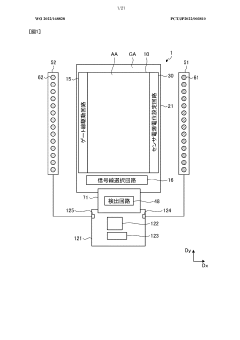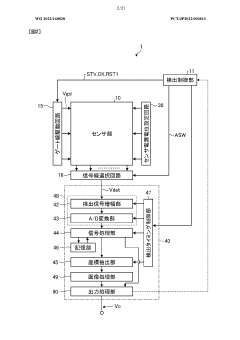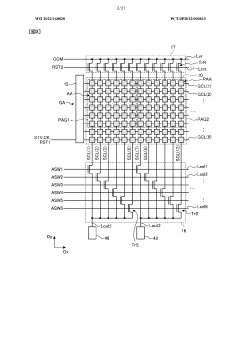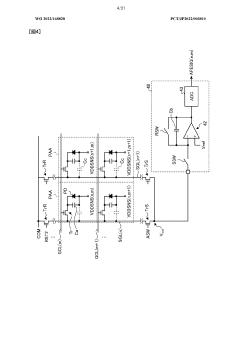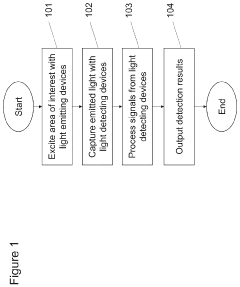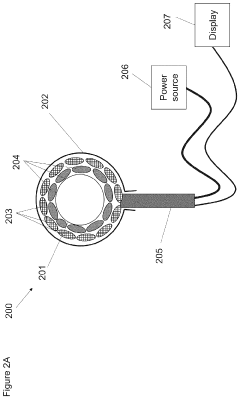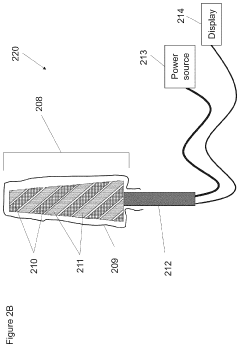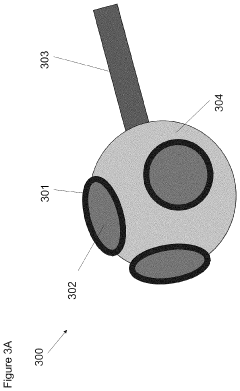Photodiode systems for precision biometric identification
AUG 21, 20259 MIN READ
Generate Your Research Report Instantly with AI Agent
Patsnap Eureka helps you evaluate technical feasibility & market potential.
Photodiode Biometrics: Background and Objectives
Photodiode-based biometric systems have emerged as a cutting-edge technology in the field of precision identification. These systems leverage the unique properties of photodiodes to capture and analyze biological characteristics with unprecedented accuracy. The evolution of this technology can be traced back to the early 2000s when researchers first began exploring the potential of photodiodes for biometric applications.
The primary objective of research in this area is to develop highly reliable and efficient identification systems that can operate in various environmental conditions. Photodiodes, known for their rapid response times and high sensitivity to light, offer significant advantages over traditional biometric sensors. They enable the capture of minute details in biological features, such as the intricate patterns of irises or the subtle variations in skin texture.
As the technology has progressed, researchers have focused on enhancing the precision and robustness of photodiode-based biometric systems. Key milestones include the development of multi-spectral imaging techniques, which allow for the capture of biometric data across different light wavelengths, improving accuracy and reducing the risk of spoofing attacks.
The trend in photodiode biometrics is moving towards miniaturization and integration with other technologies. This includes the incorporation of artificial intelligence and machine learning algorithms to improve pattern recognition and decision-making processes. Additionally, there is a growing emphasis on developing low-power consumption systems to enable widespread adoption in portable and wearable devices.
One of the most significant challenges in this field is achieving consistent performance across diverse lighting conditions and skin tones. Researchers are actively working on adaptive algorithms and advanced signal processing techniques to address these issues. Another area of focus is the development of non-invasive methods for capturing biometric data, which is crucial for user acceptance and widespread adoption.
The potential applications of photodiode-based biometric systems extend far beyond traditional security and access control. They are being explored for use in healthcare for patient identification and monitoring, in financial services for secure transactions, and in smart home technologies for personalized user experiences. The ongoing research aims to push the boundaries of what is possible in terms of accuracy, speed, and reliability in biometric identification.
The primary objective of research in this area is to develop highly reliable and efficient identification systems that can operate in various environmental conditions. Photodiodes, known for their rapid response times and high sensitivity to light, offer significant advantages over traditional biometric sensors. They enable the capture of minute details in biological features, such as the intricate patterns of irises or the subtle variations in skin texture.
As the technology has progressed, researchers have focused on enhancing the precision and robustness of photodiode-based biometric systems. Key milestones include the development of multi-spectral imaging techniques, which allow for the capture of biometric data across different light wavelengths, improving accuracy and reducing the risk of spoofing attacks.
The trend in photodiode biometrics is moving towards miniaturization and integration with other technologies. This includes the incorporation of artificial intelligence and machine learning algorithms to improve pattern recognition and decision-making processes. Additionally, there is a growing emphasis on developing low-power consumption systems to enable widespread adoption in portable and wearable devices.
One of the most significant challenges in this field is achieving consistent performance across diverse lighting conditions and skin tones. Researchers are actively working on adaptive algorithms and advanced signal processing techniques to address these issues. Another area of focus is the development of non-invasive methods for capturing biometric data, which is crucial for user acceptance and widespread adoption.
The potential applications of photodiode-based biometric systems extend far beyond traditional security and access control. They are being explored for use in healthcare for patient identification and monitoring, in financial services for secure transactions, and in smart home technologies for personalized user experiences. The ongoing research aims to push the boundaries of what is possible in terms of accuracy, speed, and reliability in biometric identification.
Market Analysis for Biometric Identification Systems
The biometric identification market has experienced significant growth in recent years, driven by increasing security concerns and the need for more reliable authentication methods. The global biometric system market size was valued at USD 36.6 billion in 2020 and is projected to reach USD 68.6 billion by 2025, growing at a CAGR of 13.4% during the forecast period. This growth is attributed to the rising adoption of biometric technologies across various sectors, including government, banking and finance, healthcare, and consumer electronics.
Photodiode-based biometric systems, particularly those used for precision identification, represent a crucial segment within this market. These systems offer advantages such as high accuracy, fast response times, and compact form factors, making them ideal for applications ranging from smartphone facial recognition to secure access control in high-security facilities.
The demand for photodiode-based biometric identification systems is primarily driven by the increasing need for enhanced security measures in both public and private sectors. Governments worldwide are implementing biometric identification systems for border control, national ID programs, and law enforcement purposes. The financial sector is adopting these technologies for secure transactions and fraud prevention, while healthcare providers are using biometric systems for patient identification and record management.
In the consumer electronics market, photodiode-based biometric systems are becoming standard features in smartphones, tablets, and laptops. The integration of facial recognition and fingerprint sensors in these devices is fueling market growth, with major manufacturers competing to offer more advanced and secure biometric features.
The Asia-Pacific region is expected to witness the highest growth rate in the biometric identification market, driven by large-scale government initiatives, rapid technological advancements, and increasing smartphone penetration. North America and Europe remain significant markets, with a focus on advanced security solutions and regulatory compliance.
Key challenges in the market include privacy concerns, data security issues, and the need for standardization across different biometric technologies. However, ongoing research and development in photodiode technology, machine learning algorithms, and data encryption methods are addressing these challenges and opening up new opportunities for market expansion.
As the demand for more secure and convenient authentication methods continues to rise, the market for photodiode-based precision biometric identification systems is poised for substantial growth. Innovations in sensor technology, miniaturization, and integration with artificial intelligence are expected to drive the next wave of advancements in this field, further expanding the market potential and applications of these systems.
Photodiode-based biometric systems, particularly those used for precision identification, represent a crucial segment within this market. These systems offer advantages such as high accuracy, fast response times, and compact form factors, making them ideal for applications ranging from smartphone facial recognition to secure access control in high-security facilities.
The demand for photodiode-based biometric identification systems is primarily driven by the increasing need for enhanced security measures in both public and private sectors. Governments worldwide are implementing biometric identification systems for border control, national ID programs, and law enforcement purposes. The financial sector is adopting these technologies for secure transactions and fraud prevention, while healthcare providers are using biometric systems for patient identification and record management.
In the consumer electronics market, photodiode-based biometric systems are becoming standard features in smartphones, tablets, and laptops. The integration of facial recognition and fingerprint sensors in these devices is fueling market growth, with major manufacturers competing to offer more advanced and secure biometric features.
The Asia-Pacific region is expected to witness the highest growth rate in the biometric identification market, driven by large-scale government initiatives, rapid technological advancements, and increasing smartphone penetration. North America and Europe remain significant markets, with a focus on advanced security solutions and regulatory compliance.
Key challenges in the market include privacy concerns, data security issues, and the need for standardization across different biometric technologies. However, ongoing research and development in photodiode technology, machine learning algorithms, and data encryption methods are addressing these challenges and opening up new opportunities for market expansion.
As the demand for more secure and convenient authentication methods continues to rise, the market for photodiode-based precision biometric identification systems is poised for substantial growth. Innovations in sensor technology, miniaturization, and integration with artificial intelligence are expected to drive the next wave of advancements in this field, further expanding the market potential and applications of these systems.
Current Challenges in Photodiode-based Biometrics
Photodiode-based biometric systems face several significant challenges that hinder their widespread adoption and effectiveness in precision identification applications. One of the primary issues is the sensitivity of photodiodes to ambient light conditions. Variations in lighting can significantly affect the quality and consistency of biometric data captured, leading to potential errors in identification or authentication processes.
Another challenge lies in the miniaturization of photodiode systems for portable and wearable biometric devices. As the demand for compact and unobtrusive biometric solutions grows, reducing the size of photodiode arrays while maintaining their performance and accuracy becomes increasingly difficult. This miniaturization process often results in compromises between sensor size, resolution, and overall system performance.
The speed of data acquisition and processing in photodiode-based biometric systems also presents a significant hurdle. High-speed, real-time biometric identification requires rapid data capture and analysis. However, current photodiode technologies may struggle to meet these demands, especially in applications requiring continuous monitoring or high-throughput screening.
Noise reduction and signal-to-noise ratio (SNR) improvement remain ongoing challenges in photodiode-based biometrics. Environmental factors, electronic noise, and thermal fluctuations can all contribute to degradation of the biometric signal quality. Developing effective noise cancellation techniques and improving the inherent SNR of photodiode sensors is crucial for enhancing the accuracy and reliability of biometric identification systems.
The issue of cross-talk between adjacent photodiodes in array configurations is another area of concern. As pixel densities increase to improve resolution, the risk of signal interference between neighboring photodiodes also rises. This cross-talk can lead to blurring or distortion of biometric data, potentially compromising the precision of the identification process.
Furthermore, the durability and longevity of photodiode sensors in biometric applications pose challenges, particularly in harsh environments or high-usage scenarios. Ensuring consistent performance over time and developing robust protection mechanisms against physical damage, environmental stressors, and degradation are essential for the long-term viability of these systems.
Lastly, the integration of photodiode-based biometric systems with other technologies, such as machine learning algorithms and secure data management platforms, presents complex challenges. Seamless integration is crucial for creating comprehensive, efficient, and secure biometric identification solutions that can adapt to evolving security needs and technological advancements.
Another challenge lies in the miniaturization of photodiode systems for portable and wearable biometric devices. As the demand for compact and unobtrusive biometric solutions grows, reducing the size of photodiode arrays while maintaining their performance and accuracy becomes increasingly difficult. This miniaturization process often results in compromises between sensor size, resolution, and overall system performance.
The speed of data acquisition and processing in photodiode-based biometric systems also presents a significant hurdle. High-speed, real-time biometric identification requires rapid data capture and analysis. However, current photodiode technologies may struggle to meet these demands, especially in applications requiring continuous monitoring or high-throughput screening.
Noise reduction and signal-to-noise ratio (SNR) improvement remain ongoing challenges in photodiode-based biometrics. Environmental factors, electronic noise, and thermal fluctuations can all contribute to degradation of the biometric signal quality. Developing effective noise cancellation techniques and improving the inherent SNR of photodiode sensors is crucial for enhancing the accuracy and reliability of biometric identification systems.
The issue of cross-talk between adjacent photodiodes in array configurations is another area of concern. As pixel densities increase to improve resolution, the risk of signal interference between neighboring photodiodes also rises. This cross-talk can lead to blurring or distortion of biometric data, potentially compromising the precision of the identification process.
Furthermore, the durability and longevity of photodiode sensors in biometric applications pose challenges, particularly in harsh environments or high-usage scenarios. Ensuring consistent performance over time and developing robust protection mechanisms against physical damage, environmental stressors, and degradation are essential for the long-term viability of these systems.
Lastly, the integration of photodiode-based biometric systems with other technologies, such as machine learning algorithms and secure data management platforms, presents complex challenges. Seamless integration is crucial for creating comprehensive, efficient, and secure biometric identification solutions that can adapt to evolving security needs and technological advancements.
Existing Photodiode Biometric Solutions
01 Precision photodiode design and fabrication
Advanced techniques in photodiode design and fabrication to enhance precision. This includes optimizing the semiconductor structure, improving doping profiles, and refining the manufacturing process to reduce noise and increase sensitivity. These methods result in photodiodes with higher quantum efficiency and lower dark current, crucial for precision applications.- Precision photodiode design and fabrication: Advanced photodiode designs and fabrication techniques are employed to enhance precision in photodiode systems. These include optimized semiconductor structures, improved doping profiles, and novel materials to increase sensitivity and reduce noise. Precision fabrication processes ensure consistent performance across devices.
- Signal processing and amplification for precision: Sophisticated signal processing and amplification techniques are implemented to improve the precision of photodiode systems. This includes low-noise amplifiers, advanced filtering methods, and high-resolution analog-to-digital converters. These techniques help to extract weak signals and minimize interference, enhancing overall system precision.
- Temperature compensation and stabilization: Precision photodiode systems incorporate temperature compensation and stabilization mechanisms to maintain accuracy across varying environmental conditions. This may involve temperature sensors, feedback loops, and adaptive algorithms to adjust for temperature-induced variations in photodiode response.
- Optical design for improved precision: Precision optical designs are crucial for enhancing photodiode system performance. This includes optimized lens systems, filters, and light guides to focus and direct light efficiently onto the photodiode surface. Advanced optical coatings may also be used to reduce reflections and improve light collection efficiency.
- Calibration and error correction techniques: Sophisticated calibration and error correction techniques are employed to achieve high precision in photodiode systems. These may include factory calibration, self-calibration routines, and real-time error correction algorithms. Advanced software and firmware implementations help compensate for various sources of error and drift over time.
02 Signal processing and amplification for precision photodiode systems
Innovative signal processing and amplification techniques to improve the precision of photodiode systems. This involves the development of low-noise amplifiers, advanced filtering methods, and high-resolution analog-to-digital converters. These technologies help to extract weak signals from noise and enhance the overall system performance.Expand Specific Solutions03 Temperature compensation and stabilization in photodiode systems
Methods for temperature compensation and stabilization to maintain precision in varying environmental conditions. This includes the integration of temperature sensors, implementation of feedback control systems, and the use of materials with low thermal expansion coefficients. These approaches help to minimize temperature-induced drift and ensure consistent performance across a wide temperature range.Expand Specific Solutions04 Integration of photodiodes in precision optical systems
Techniques for integrating photodiodes into larger optical systems for high-precision applications. This involves optimizing the optical path, minimizing stray light, and developing specialized packaging solutions. These methods improve the overall system performance in applications such as spectroscopy, laser rangefinding, and optical communication.Expand Specific Solutions05 Calibration and error correction for precision photodiode measurements
Advanced calibration and error correction techniques to enhance the accuracy of photodiode measurements. This includes the development of automated calibration procedures, implementation of real-time error correction algorithms, and the use of reference standards. These methods help to compensate for systematic errors and improve the long-term stability of photodiode systems.Expand Specific Solutions
Key Players in Photodiode Biometric Industry
The research on photodiode systems for precision biometric identification is in a growth phase, with increasing market size due to rising demand for secure authentication methods. The global biometric technology market is expected to reach significant value in the coming years. Technologically, the field is advancing rapidly, with companies like HID Global GmbH, Koninklijke Philips NV, and Japan Display, Inc. leading innovations. These firms are developing sophisticated photodiode systems that offer improved accuracy and reliability in biometric identification. Other players like MGI Tech Co., Ltd. and SiOnyx LLC are contributing to the technological maturity by focusing on specialized applications and enhancing sensor capabilities. The competitive landscape is diverse, with both established tech giants and innovative startups vying for market share.
Princeton Identity, Inc.
Technical Solution: Princeton Identity specializes in iris recognition systems using advanced photodiode technology. Their systems employ near-infrared illumination and high-resolution image sensors to capture detailed iris patterns at a distance[9]. The company's technology incorporates machine learning algorithms for rapid iris detection and matching, allowing for identification at a range of up to 2 meters. Princeton Identity's systems are designed for high-throughput environments and can perform identification in less than a second, even for individuals in motion[10].
Strengths: Long-range capability, high-speed processing, and compatibility with existing security infrastructures. Weaknesses: May be more expensive than other biometric modalities for some applications.
Shenzhen Goodix Technology Co., Ltd.
Technical Solution: Goodix has pioneered optical in-display fingerprint sensors using photodiode arrays. Their technology employs a thin OLED display as a light source and an array of high-sensitivity photodiodes to capture fingerprint images through the screen[7]. The system uses proprietary algorithms to enhance image quality and accuracy, allowing for secure biometric authentication without dedicated sensor areas on device exteriors. Goodix's latest sensors feature improved anti-spoofing capabilities and can operate through thicker display stacks, expanding their potential applications[8].
Strengths: Seamless integration with displays, large sensing area, and continuous technological improvements. Weaknesses: Potential for higher power consumption compared to capacitive sensors.
Core Innovations in Photodiode Systems
Detection device
PatentWO2022168828A1
Innovation
- A detection device with multiple photodiodes that individually control reverse bias voltage, using a power supply control circuit to apply different potentials based on signal output levels, thereby stabilizing the detection process across various detection regions.
Systems for Biomarker Detection and Methods Thereof
PatentPendingUS20240023811A1
Innovation
- A biomarker detection system comprising a light emitting diode that excites biomarkers to emit light in the UV wavelength range of 100 nm to 450 nm, combined with a light detecting device such as a photodiode or CMOS camera, and a signal processor to generate detection results, with optional anti-reflective coatings and power sources for portability and accuracy.
Regulatory Framework for Biometric Systems
The regulatory framework for biometric systems, particularly those utilizing photodiode technology for precision identification, is a complex and evolving landscape. Governments and international bodies have recognized the need for comprehensive guidelines to address privacy concerns, data protection, and ethical use of biometric data.
In the United States, the use of biometric systems is governed by a patchwork of federal and state laws. The Federal Trade Commission (FTC) plays a crucial role in enforcing privacy and data security practices, while specific regulations like the Health Insurance Portability and Accountability Act (HIPAA) govern biometric data in healthcare settings. Several states, including Illinois, Texas, and Washington, have enacted specific biometric privacy laws that require consent for collection and strict guidelines for storage and use of biometric information.
The European Union's General Data Protection Regulation (GDPR) sets a global standard for data protection, including biometric data. Under GDPR, biometric data is classified as sensitive personal data, subject to stringent processing and storage requirements. Organizations must obtain explicit consent from individuals and implement robust security measures to protect this data.
In Asia, countries like China and India have implemented large-scale biometric identification systems, necessitating the development of comprehensive regulatory frameworks. China's Cybersecurity Law and Personal Information Protection Law provide guidelines for collecting and processing biometric data. India's Aadhaar system, one of the world's largest biometric databases, is governed by the Aadhaar Act, which outlines data protection and privacy measures.
International standards bodies, such as the International Organization for Standardization (ISO) and the International Electrotechnical Commission (IEC), have developed standards specific to biometric systems. ISO/IEC 19794 series provides guidelines for biometric data interchange formats, while ISO/IEC 24745 focuses on biometric information protection.
The regulatory landscape also addresses the accuracy and reliability of biometric systems. Standards like NIST Special Publication 800-76 provide technical specifications for biometric data used in personal identity verification. These standards are crucial for ensuring the precision and reliability of photodiode-based biometric identification systems.
As the technology advances, regulators are grappling with emerging challenges, such as bias in biometric systems and the potential for data breaches. Many jurisdictions are considering or implementing regulations that require regular audits of biometric systems, transparency in algorithmic decision-making, and strict penalties for non-compliance.
The global nature of biometric technology necessitates international cooperation in developing regulatory frameworks. Organizations like the Biometrics Institute provide guidelines and best practices that aim to harmonize regulations across borders, promoting responsible and ethical use of biometric systems worldwide.
In the United States, the use of biometric systems is governed by a patchwork of federal and state laws. The Federal Trade Commission (FTC) plays a crucial role in enforcing privacy and data security practices, while specific regulations like the Health Insurance Portability and Accountability Act (HIPAA) govern biometric data in healthcare settings. Several states, including Illinois, Texas, and Washington, have enacted specific biometric privacy laws that require consent for collection and strict guidelines for storage and use of biometric information.
The European Union's General Data Protection Regulation (GDPR) sets a global standard for data protection, including biometric data. Under GDPR, biometric data is classified as sensitive personal data, subject to stringent processing and storage requirements. Organizations must obtain explicit consent from individuals and implement robust security measures to protect this data.
In Asia, countries like China and India have implemented large-scale biometric identification systems, necessitating the development of comprehensive regulatory frameworks. China's Cybersecurity Law and Personal Information Protection Law provide guidelines for collecting and processing biometric data. India's Aadhaar system, one of the world's largest biometric databases, is governed by the Aadhaar Act, which outlines data protection and privacy measures.
International standards bodies, such as the International Organization for Standardization (ISO) and the International Electrotechnical Commission (IEC), have developed standards specific to biometric systems. ISO/IEC 19794 series provides guidelines for biometric data interchange formats, while ISO/IEC 24745 focuses on biometric information protection.
The regulatory landscape also addresses the accuracy and reliability of biometric systems. Standards like NIST Special Publication 800-76 provide technical specifications for biometric data used in personal identity verification. These standards are crucial for ensuring the precision and reliability of photodiode-based biometric identification systems.
As the technology advances, regulators are grappling with emerging challenges, such as bias in biometric systems and the potential for data breaches. Many jurisdictions are considering or implementing regulations that require regular audits of biometric systems, transparency in algorithmic decision-making, and strict penalties for non-compliance.
The global nature of biometric technology necessitates international cooperation in developing regulatory frameworks. Organizations like the Biometrics Institute provide guidelines and best practices that aim to harmonize regulations across borders, promoting responsible and ethical use of biometric systems worldwide.
Ethical Implications of Biometric Technology
The rapid advancement of photodiode systems for precision biometric identification raises significant ethical concerns that must be carefully addressed. As these technologies become more sophisticated and widespread, they have the potential to infringe upon individual privacy and civil liberties. One primary concern is the collection and storage of sensitive biometric data, which, if compromised, could lead to severe consequences for individuals, including identity theft and unauthorized surveillance.
The use of biometric identification systems also raises questions about consent and transparency. Individuals may not always be aware that their biometric data is being collected or how it will be used, stored, or shared. This lack of informed consent can lead to a erosion of trust between citizens and institutions implementing these technologies. Furthermore, there are concerns about the potential for mission creep, where biometric data collected for one purpose may be used for unintended or unauthorized purposes in the future.
Another critical ethical consideration is the potential for bias and discrimination in biometric systems. Research has shown that some biometric technologies, including facial recognition systems, can exhibit varying levels of accuracy across different demographic groups. This disparity could lead to unfair treatment or false identifications, particularly affecting marginalized communities. Ensuring fairness and non-discrimination in the development and deployment of biometric technologies is crucial to maintain social justice and equality.
The implementation of biometric identification systems also raises questions about the balance between security and individual freedom. While these technologies may enhance public safety and streamline various processes, they also have the potential to create a surveillance state where personal movements and activities are constantly monitored. This level of scrutiny could have a chilling effect on free expression and association, fundamentally altering the nature of public spaces and social interactions.
Lastly, the long-term implications of widespread biometric data collection and use must be considered. As artificial intelligence and data analytics continue to advance, the aggregation of biometric data with other personal information could lead to unprecedented levels of profiling and prediction of individual behavior. This raises profound questions about personal autonomy, free will, and the right to privacy in an increasingly digitized world. Addressing these ethical challenges requires a multidisciplinary approach, involving technologists, policymakers, ethicists, and civil society to develop robust frameworks for the responsible development and use of biometric technologies.
The use of biometric identification systems also raises questions about consent and transparency. Individuals may not always be aware that their biometric data is being collected or how it will be used, stored, or shared. This lack of informed consent can lead to a erosion of trust between citizens and institutions implementing these technologies. Furthermore, there are concerns about the potential for mission creep, where biometric data collected for one purpose may be used for unintended or unauthorized purposes in the future.
Another critical ethical consideration is the potential for bias and discrimination in biometric systems. Research has shown that some biometric technologies, including facial recognition systems, can exhibit varying levels of accuracy across different demographic groups. This disparity could lead to unfair treatment or false identifications, particularly affecting marginalized communities. Ensuring fairness and non-discrimination in the development and deployment of biometric technologies is crucial to maintain social justice and equality.
The implementation of biometric identification systems also raises questions about the balance between security and individual freedom. While these technologies may enhance public safety and streamline various processes, they also have the potential to create a surveillance state where personal movements and activities are constantly monitored. This level of scrutiny could have a chilling effect on free expression and association, fundamentally altering the nature of public spaces and social interactions.
Lastly, the long-term implications of widespread biometric data collection and use must be considered. As artificial intelligence and data analytics continue to advance, the aggregation of biometric data with other personal information could lead to unprecedented levels of profiling and prediction of individual behavior. This raises profound questions about personal autonomy, free will, and the right to privacy in an increasingly digitized world. Addressing these ethical challenges requires a multidisciplinary approach, involving technologists, policymakers, ethicists, and civil society to develop robust frameworks for the responsible development and use of biometric technologies.
Unlock deeper insights with Patsnap Eureka Quick Research — get a full tech report to explore trends and direct your research. Try now!
Generate Your Research Report Instantly with AI Agent
Supercharge your innovation with Patsnap Eureka AI Agent Platform!
